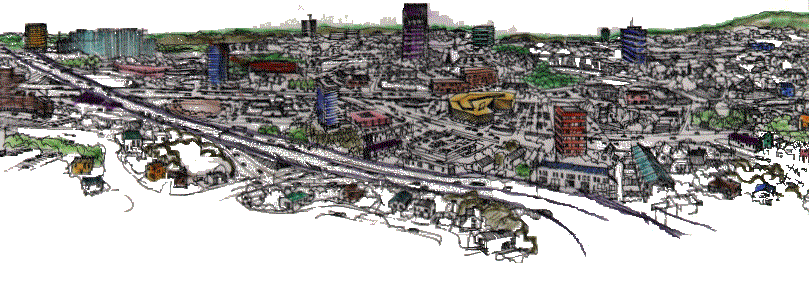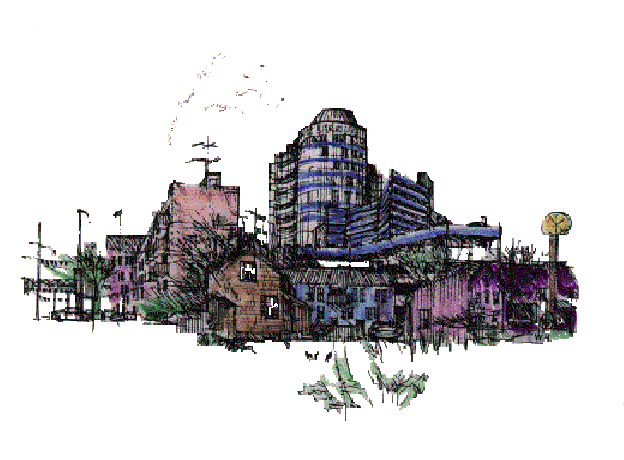

The landscape of U.S. metropolitan areas increasingly reflects a synthesis of urban and suburban building styles and land use patterns. The central part of the metropolis remains urban in its building density, population density, and building height. Conversely, the mixture of single-family homes, asphalt, and greenery on the fringe of the metropolis reflects a lower physical density that deserves to be called suburban. But much of the metropolitan landscape falls between these conditions. It is instead an intermediate landscape, which I call semi-urban.
The first sign of the semi-urban landscape appears to be an unexpected juxtaposition of forms and functions from the neighboring suburban ring and city core. Yet much visual evidence indicates that a distinctive semi-urban building style and land use pattern is emerging. It mostly straddles the zone sometimes called the inner suburbs, but it also penetrates the central city and outer suburbs along major highways.
A spatial blend of several housing forms characterizes the residential component of the semi-urban landscape. Townhouses, low-rise apartments, and garden apartments are common features of this mixed-density landscape. Many residences are purchased as condominiums; garden apartments are the most common rental units. These residential forms reflect a compromise between the suburban ideal of home ownership and the urban ideal of economy through cluster. Single-family homes (characteristic of the outer suburbs) and high-rise apartments (characteristic of the city) are interspersed among the townhouse and garden apartment developments.
Like the residences, commercial and industrial structures in semi-urban areas are usually multi-story, but not high-rise. Two-level enclosed malls or open shopping plazas are common. Office buildings for doctors, lawyers, banks, and real estate firms rise three or more stories. Multi-level industrial buildings also can be seen, particularly in the campus atmosphere of research-industrial parks. Single-story and high-rise buildings are interspersed now and then with medium-height structures. While individual building sites are well-manicured, many semi-urban landscapes are unsightly when viewed from a distance.
Roads and parking facilities that blend urban and suburban styles characterize semi-urban landscapes. These mixed intensity areas are usually located along the major transport arteries, such as radial highways and metropolitan beltways. Traffic volume demands traffic control lights and stop signs as in urban areas. Yet lack of on-street parking and the absence of buildings fronting immediately on the roads gives traffic flow a suburban style and speed. Some semi-urban areas compromise between urban and suburban styles by having access roads parallel to the highway, a solution that alleviates some traffic problems, but creates obstacle courses for pedestrians. Parking is free and finding a space is generally easier (and cheaper) than in urban areas, yet the congestion in the lots, the walking distance from parking space to destination, and the multi-deck parking facilities differentiate semi-urban landscapes from suburban landscapes.
Location along major highways with access roads, structures of varying height, and parking facilities give the semi-urban landscape a distinctive combination of vertical and horizontal space use, which contrasts with that of both urban and suburban landscapes. In urban landscapes the image and use of vertical space predominates. The suburban image is intensified by the viewer's perception of "empty" (sometimes wooded) space between and behind structures. In semi-urbanized landscapes, buildings are multi-storied, but not tall nor compact enough to create the strong vertical image of urban areas. The viewer's eyes are still drawn to horizontal expanses between structures. Unlike suburbia, however, these spaces are intensively used for roads and parking lots.
The familiar "push forces" involved in the decentralization of metropolitan regions are also behind the evolution of the semi-urban landscape. Urbanization of the suburbs is a closely related concept. However, the idea of the "suburbanization of the city" is a useful conceptual device for understanding how various density-decreasing forces are shaping the semi-urban landscape. Clearing urban structures to make room for freeways, parking lots, gas stations, drive-in banks, and fast food chains reduces building and population densities. Much of this auto-related change is a response to suburbanites' commuting needs. Meanwhile the urbanization of the inner suburbs continues, increasing suburban building and population densities through the construction of high-rise office and apartment buildings. While the urbanizing influences have reached out to the farthest suburb, and the suburbanizing influences have struck close to the heart of the central business district, most of the battle has been fought in the inner suburbs. A degree of equilibrium between these density-increasing and density-decreasing forces has smoothed the landscape transition between city and suburb, and this equilibrium is reflected in the semi-urban landscape.
Several forces shaping the semi-urban landscape deserve special mention. The demand for parking space is particularly important. In urban areas, parking lot construction decreases building density and gives the landscape a more suburbanized image, even if the parking lot is only temporary. ln suburban areas the desire to reduce land costs results in multi-story buildings and multi-level parking lots, which produce a more urbanized landscape.
The semi-urban landscape also is shaped in part by demands for more functional open space and for intensified suburban development. Zoning and growth restrictions in the suburban ring constrain the areal enlargement of the metropolis and encourage conversion from suburban to semi-urban densities. Such restrictions as well as prevailing economic conditions also induce the higher densities characteristic of the semi-urban landscape in many new sites where development is permitted. In urban areas, space left vacant by incomplete development projects, and open space created for visual impact and recreation may reduce existing densities. Creation and maintenance of open space blurs the distinction between urban and suburban building densities in the same way as the construction of parking lots.
The growing number of people willing to live in semi-urban residences also has spurred the growth of the semi-urban landscape. Increases in the costs of land, construction, gasoline, home energy, and taxes have raised the cost of the cherished suburban lifestyle. Semi-urban townhouses and garden condominiums closely approximate the suburban lifestyle at a lower price for increasing numbers of metropolitan households. Demographic changes, such as fewer and later marriages, an increase in the divorce rate, and a decrease in the birth rate are reducing the size of the average household and increasing the ranks of families willing to live in smaller units on smaller parcels of land.
A final contributing factor toward the evolution of the semi-urban landscape has been the realignment of highways This change has opened undeveloped areas of the metropolitan region to semi-urbanization. At the same time, it has made many suburbanized areas more accessible to the metropolis and more subject to pressures for intensified land development. Cross-city highways, beltways, and interstate highways near metropolitan regions have created many sites ripe for semi-urbanization. The decentralization of employment centers often has encouraged the development of semi-urban landscapes, due to the clustering of subsidiary residential and commercial developments around these employment centers.
Trends suggest that the semi-urban landscape will continue to grow and that the number of people who live, work, and shop under these conditions will increase. Awareness of this semi-urban landscape has both an aesthetic and a practical value for semi-urbanites. Recognition of the semi-urban landscape as a logical outcome of competing urban and suburban influences imparts a perceptual integrity to the landscape in an area that lacks a ready definition. It is aesthetically more pleasing to reside in a landscape with strong identity, rather than be part of an amorphous area known as "not city, yet not suburb." In time, the semi-urban landscape may come to reflect a whole environment: a way of life distinct from urban and suburban lifestyles.
